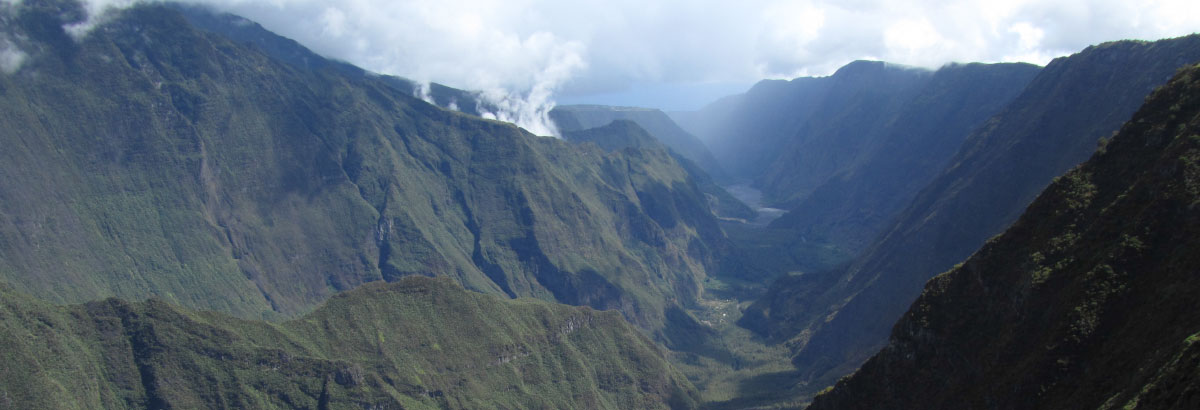
Eins der zentralen Ziele unserer Abteilung ist es, makroevolutionäre, mikroevolutionäre und ökologische Forschung miteinander zu verbinden.
Als wir herausgefunden hatten, dass P. pacificus die am weitesten verbreitete Art der Gattung Pristionchus ist (es gibt Aufsammlungen aus Asien, Nordamerika, Südamerika, Europa und Südafrika (Zauner et al., 2007), wählten wir die Insel La Réunion im Indischen Ozean für eine erste Studie über die Biogeographie von Nematoden auf Inseln. Reunion war die erste Wahl, weil
i) dort eine Vielzahl endemischer und eingeschleppter Blatthornkäfer-Arten vorkommen,
ii) die Insel vulkanischen Ursprungs und gerade einmal 2-3 Millionen Jahre jung und noch dazu
iii) ein französisches Überseedepartement mit herausragender Infrastruktur ist.
Untersuchungen in den Jahren 2008 bis 2011 ergaben eine Menge überraschender und vielversprechender Erkenntnisse.
Seit 2010 haben wir eine kleine Forschungsstation auf La Réunion.
Artikel in der ZEIT über unsere Forschung
In Kooperation mit:
Moreno, E. & Sommer, R. J. (2018): A cilia-mediated environmental input induces solitary behaviour in Caenorhabditis elegans and Pristionchus pacificus nematodes. Nematology, 20, 201-209.
Moreno, E., Sieriebriennikov, B., Witte, H., Rödelsperger, C., Lightfoot, J. W. & Sommer, R. J. (2017): Regulation of hyperoxia-inducted social behaviour in Pristionchus pacificus nematodes requires a novel cilia-mediated environmental input. Scientific Reports, 7: 17550.
Meyer, J. M., Baskaran, P., Quast, C., Susoy, V., Rödelsperger, C., Glöckner, F. O. & Sommer, R. J. (2017): Succession and dynamics of Pristionchus nematodes and their microbiome during decomposition of Oryctes borbonicus on La Réunion Island. Environm. Microbiology, 19, 1476-1489.
Susoy, V., Herrmann, M., Kanzaki, N., Kruger, M., Nguyen, C. N., Rödelsperger, C., Röseler, W., Weiler, C., Giblin-Davis, R. M., Ragsdale, E. J. & Sommer, R. J. (2016): Large-scale diversification without genetic isolation in nematode symbionts of figs. Science Advance, 2: e1501031.
McGaughran, A., Morgan K. & Sommer, R. J. (2014): Post hoc association analyses in a hermaphroditic nematode support significant genotype-environmental interactions. PLOS ONE, 9: e87317. doi:10.1371/journal.pone.0087317.
Morgan, K., McGaughran, A., Ganeshan, S., Herrmann, M., & Sommer, R. J. (2014): Landscape and oceanic barriers shape dispersal and population structure in the Island nematode Pristionchus pacificus. Biol. Journal Linnean Soc., 12, 1-15.
McGaughran, A., Morgan K. & Sommer, R. J. (2013): Natural variation in chemosensation: lessons from an island nematode. Ecol. & Evol., 3, 5209-5224.
Sommer, R. J. & McGaughran, A. (2013): The nematode Pristionchus pacificus as a model system for integrative studies in evolutionary biology. Mol. Ecol., 22, 2380-2393.
McGaughran, A., Morgan K. & Sommer, R. J. (2013): Unravelling the evolutionary history of the nematode Pristionchus pacificus: from lineage diversification to island colonization. Evolution & Ecology, 3, 667-675.
Morgan, K., McGaughran, A., Witte, H., Bartelmes, G., Villate, L., Herrmann, M., Rochat, J. & Sommer, R. J. (2012): Multi-locus analysis of Pristionchus pacificus on La Réunion Island reveals an evolutionary history shaped by multiple introductions, constrained dispersal events, and rare out-crossing. Mol Ecol., 21 (2), 250-266.
Herrrmann, M., Kienle, S., Rochat, J., Mayer, W., & Sommer, R. J. (2010): Haplotype diversity of the nematode Pristionchus pacificus on Réunion in the Indian Ocean suggests multiple independent invasions. Biol. J. Linn. Soc., 100, 170-179.